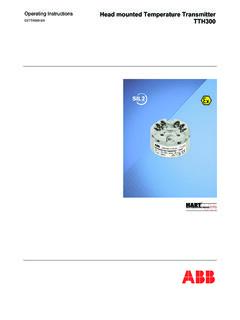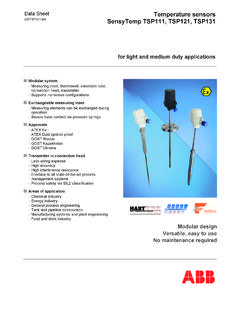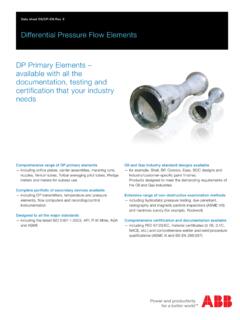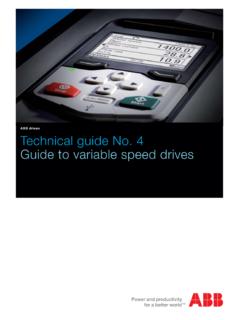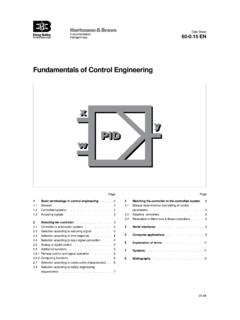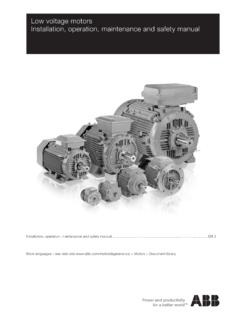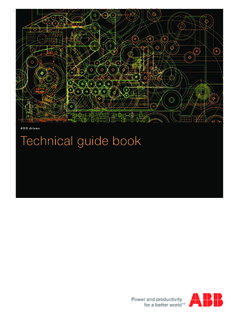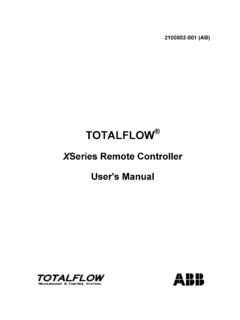Transcription of Calculation of the Current Transformer Accuracy Limit Factor
1 Calculation of the Current Transformer Accuracy Limit Factor Application Note kansikuva_bw 1 MRS 755481 Calculation of the Current Transformer Accuracy Limit Factor Issued: Version: Application Note Contents: 1. Scope ..4. 2. Introduction ..5. 3. Technical implementation ..6. Calculation of the CT burden ..6. Resistance of a conductor ..6. Resistance at higher temperatures ..6. 4- or 6-wire connection ..7. Burden of the relay ..7. Example ..8. Calculation of the actual Accuracy Limit Factor ..8. Example ..8. Alternative method ..9. 4. References ..10. 5. List of symbols ..11. Copyrights The information in this document is subject to change without notice and should not be construed as a commitment by ABB Oy.
2 ABB Oy assumes no responsibility for any errors that may appear in this docu- ment. In no event shall ABB Oy be liable for direct, indirect, special, incidental or consequential damages of any nature or kind arising from the use of this document, nor shall ABB Oy be liable for incidental or con- sequential damages arising from use of any software or hardware described in this document. This document and parts thereof must not be reproduced or copied without written permission from ABB. Oy, and the contents thereof must not be imparted to a third party nor used for any unauthorized pur- pose.
3 The software or hardware described in this document is furnished under a license and may be used, copied, or disclosed only in accordance with the terms of such license. Copyright 2004 ABB Oy All rights reserved. Copyright 2004 ABB Oy, Distribution Automation, Vaasa, FINLAND 3. Calculation of the Current Transformer 1 MRS 755481. Accuracy Limit Factor 1. Scope This document describes the Calculation of the actual Accuracy Limit Factor (Fa) for protection-type (P) Current transformers (CT). First, the Calculation of the actual burden of the CT, including connection wires and protection relay impedance, is presented.
4 Then, two alternative methods for calculating Fa are shown. All Calculation principles and equations are illustrated with an example. The rules presented are generally used and apply, for example, to protection Calculation of SPACOM and RED 500 series protection relays. KEYWORDS: Current Transformer , Accuracy Limit Factor , Accuracy Limit primary Current . 4. 1 MRS 755481 Calculation of the Current Transformer Accuracy Limit Factor 2. Introduction The rated Accuracy Limit Factor (Fn) is the ratio of the rated Accuracy Limit primary Current to the rated primary Current . A protective Current Transformer type 5P10 has, for example, the Accuracy class 5P and the rated Accuracy Limit Factor 10.
5 For protective Current transformers, the Accuracy class is determined by the highest permissible percentage composite error at the rated Accuracy Limit primary Current specified for the Accuracy class concerned, followed by the letter P (referring to protection). The CT Accuracy primary Limit Current defines the highest fault Current magnitude at which the CT will meet the specified Accuracy . Beyond this level, the secondary Current of the CT will be distorted, and this may have severe effects on the performance of the protection relay. In practise, the actual Accuracy Limit Factor (Fa) differs from the rated Accuracy Limit Factor (Fn) and is proportional to the ratio of the rated CT burden and the actual CT.
6 Burden. For the reliable and correct operation of the protection relays, the Current Transformer (CT) has to be carefully chosen. The distortion of the secondary Current of a saturated CT may endanger the operation, selectivity and co-ordination of the protection. A correctly selected CT, on the other hand, enables fast and reliable protection. 5. Calculation of the Current Transformer 1 MRS 755481. Accuracy Limit Factor 3. Technical implementation Calculation of the CT burden The actual burden is formed by the resistance of the pilot conductors and the protection relay(s). Resistance of a conductor The resistance of a conductor (with a constant cross - sectional area) can be calculated from the equation: R = x l/A (1).
7 Where = resistivity of the conductor material (given typically at +20 C). l = length of the conductor A = cross - sectional area If the resistivity is given in m, the length in metres and the area in mm2, the equation 1 will give the resistance directly in ohms. The resistivity and temperature coefficient for copper is given in table Table Resistivity and temperature coefficient for copper (Cu). Material Resistivity (+20 C) Resistivity (+75 C) Temp. coefficient . Copper m m 1/K. Resistance at higher temperatures The resistance is temperature-dependent: when the temperature rises, the resistance will increase.
8 Therefore, the resistance of a conductor should be calculated at the worst-case temperature. Normally +75 C is used for calculations. For pure metals like copper and aluminium the dependence is almost linear in quite a wide temperature range ( +200 C). The resistance at a certain temperature T2. is calculated as follows: R2 = R1 x [1+ (T2-T1)] (2). where R1 = resistance at temperature T1. = temperature coefficient of the conductor material T1, T2 = temperatures in Kelvin (20 C = K). The resistance per cable length at +75 C for copper is given in the table and in the figure Table Resistance per cable length (+75 C) for copper Material mm2 4 mm2 6 mm2.
9 Copper /m /m /m 6. 1 MRS 755481 Calculation of the Current Transformer Accuracy Limit Factor Conductor wire resistance (copper). Resistance in 75 C (ohms). mm2. 4 mm2. 6 mm2. 0 5 10 15 20. Length of the conductor (metres). Fig. Resistance per cable length (+75 C) for copper (Cu). 4- or 6-wire connection If 6-wire connection is used, the total length of the wire, naturally, will be two times the distance between the CT and the relay. However, in many cases a common return conductor is used (figure ). Then, instead of multiplying the distance by two, a Factor of is typically used. This rule only applies to the 3-phase connection.
10 The Factor allows for a situation, where up to 20% of the electrical conductor length, including terminal resistances, uses 6-wire connection and at least 80% 4-wire connection. Fig. CT connections, 6-wire and 4-wire (common return conductor). If, for example, the distance between the CT and the relay is 5 metres the total length is 2 x 5 m = 10 metre for 6-wire connection, but only x 5 m = metre when 4- wire connection is used. Burden of the relay The burden of the relay, the relay input impedance must be checked with the relay manufacturer (User's manual, Technical data). For SPACOM relays, for example, the input impedance is less than for a 5 A input ( burden less than VA) and less than for a 1 A input ( less than VA).
